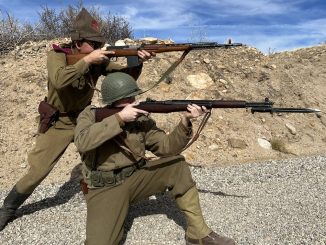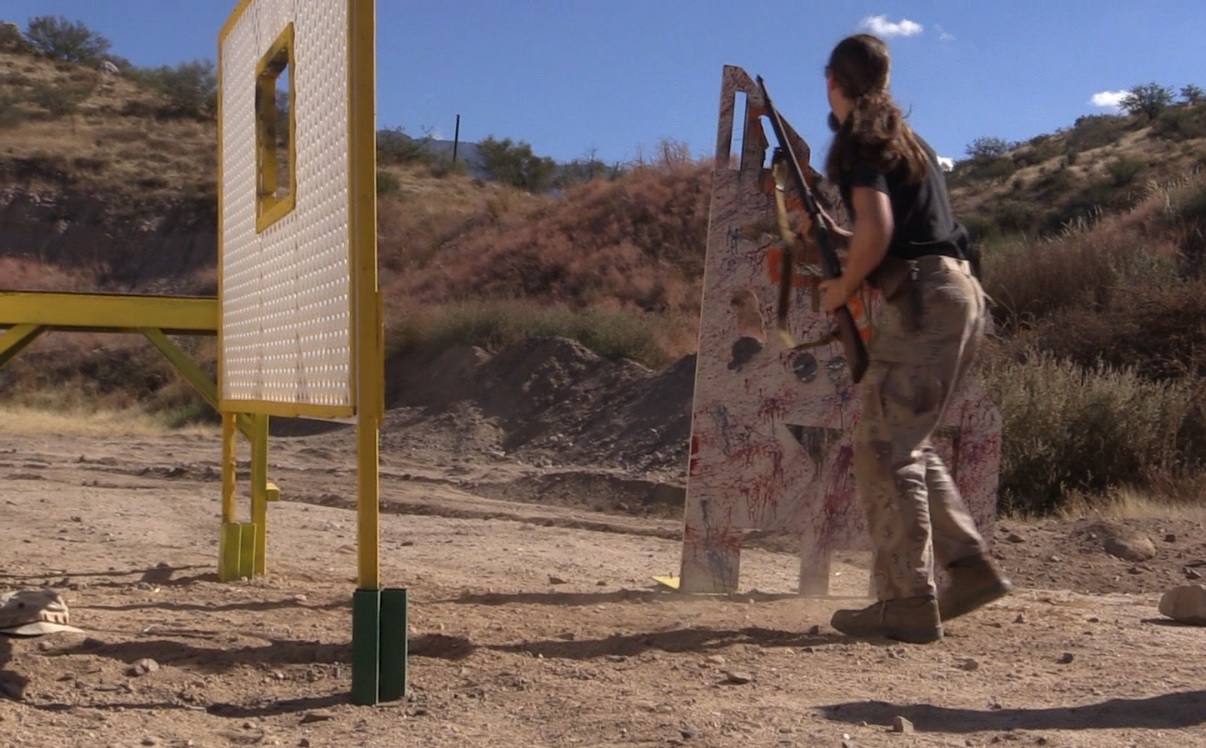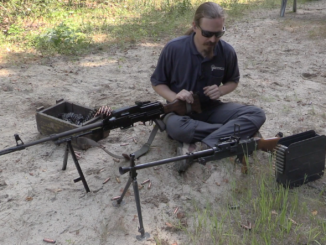Yesterday we looked at the history of the PPS-42 and how it was developed into the much more common PPS-43. Today we are taking it out to the range – the only time one of these very scarce gun has been filmed in recent history.
Related Articles

Competition
2-Gun on the Elbe: SVT40 vs M1 Garand
Today I’m taking an SVT-40 to the monthly 2-Gun Action Challenge Match, and I’m joined by my friend Tom shooting an M1 Garand. We’re both using moderately accurate gear, and so naturally I have a […]

Bolt Action Rifles
2-Gun Action Match: Mosin & Nagant vs Trapdoor & SAA
November 22, 2014
Ian McCollum
Bolt Action Rifles, Competition, Revolver, Single Shot Rifles, Video
38
No vintage photo today – instead I have a vintage rifle match! I’ve had had a bunch of people asking to see a Mosin-Nagant in one of these matches, and decided to oblige – but […]

General Purpose MGs
GPMG Firing Comparison: PKM vs UK vz.59
Since I had the opportunity to do some shooting with both a Yugoslav PKM and a Czech vz.59 general-purpose machine gun, I thought it would be interesting to compare them side by side. Which is […]

Awesome as always Ian, thank you!
The firing cadence seems rather odd – a shot, pause, then followed by two quick shots in succession in a 3 round burst. Any ideas?
A note on rate of fire. After years of hearing “Don’t load 7.62 Tok into any Mauser Broomhandle, it’s way hotter!” — which I read after years of “7.62 Tokarev is downloaded 7.63 Mauser,” I did some web-searching and found this assertion: The Soviets loaded 7.62P (their only loading through WWII for pistol or SMG) to the same pressures as 7.63 Mauser. But they used powder that gave good detonation at very cold temperatures. In temperate climates this powder creates higher pressures. Hence 7.62P becomes dangerous in old Broomhandles. If his Polish ammo is Warsaw Pact winter standard, I wonder if Mr. M would get a slower rate of fire at below zero?
I have shot a few 7.62 Tokarev rounds thru my beat-up Broomhandle. It worked, but constant use would beat it to death.
“(…)But they used powder that gave good detonation at very cold temperatures.(…)”
Various powder were used for 7,62×25 mm cartridge, http://spec-naz.org/armory/ammunition/patron_7_62h25_tt/ reports following types:
ВП
П-125
П-45
please select exactly one which you are describing.
I’m sorry but I don’t know. The author of the post only stated that the powder gave satisfactory detonation and velocity at very cold temperatures and in temperate climates exploded with greater force, which the TT-30/33 was strong enough to withstand but for the C96 was of questionable safety. The author mentioned only one kind of powder, and my other readings claimed that there was only one 7.62 loading during the war, issued for both pistols and SMGs. Of course you would know better. If the three powders you cite were differentiated and issued according to climate, rather than type of weapon or region of manufacture, the author of the post was unaware of them.
I coincidentally read an article about lend-lease Thompson guns sent to the USSR; apparently the included .45 ammunition was badly affected by cold weather, to the point that the bullet would not penetrate two layers of army winter greatcoat. That author claimed that drunken soldiers would challenge each other to put on two coats and be shot with .45s!
The question remains: was the variable firing rate of this PPS-42 the result of inconsistent ammunition or ammunition meant to be fired in the Arctic?
Respectfully yours,
The story about the .45 ammunition and winter coats is remarkably similar to the often repeated story that .30 Carbine ammunition failed to penetrate North Korean winter clothing during the Korean War. I would say both are legends borne out of the imagination of tired soldiers, but since they both involve US made ammunition in cold weather, they did give me a little pause… Just a little, though, I can’t really believe either story.
Do you still remember where you read the article about .45 ammunition? I would be interested to see if the author gives any kind of references.
https://www.thefirearmblog.com/blog/2019/09/19/forgotten-history-of-thompson-smg-in-secret-police-and-army-of-soviet-russia/
I didn’t remember but that what search engines are for …
Thanks for the link. I read the article and it seems to me that the author did not believe the stories about .45 APC ammunition, either. Interesting mythology nonetheless.
“(…)Thompson(…)USSR(…).45 ammunition(…)”
According to http://www.tankarchives.ca/2017/09/lend-lease-impressions-submachineguns.html ammunition supplied was rather lousy
11.43 mm pistol rounds had the following issues during trials:
Misfire: 6.1%
Jammed casing: 2.6%
Escaping gases: 0.6%
Tough extraction: 0.3%
Bullet stuck in gun barrel: 0.2%
An inspection of the exterior of the rounds showed a large number of protruding or sunken primers, as well as looseness. It is also established that the rounds did not come from one batch or one company, but from various years of production (as early as 1934) and companies (4 different companies).
I was going to compare Ian’s comments on the shooting experience with the PPS-43, only to find out that he hasn’t actually shot the PPS-43, at least not on video. He has only shot the Polish PPS-43/52 with a fixed wooden stock. Although on that video he makes comments which seem to compare the PPS-43/52 with a standard PPS-43, but there does not seem to be a video of him shooting the latter.
As for the rate of fire, the PPS-42 does not appear to be significantly different from the PPS-43/52, which is to be expected considering the bolts are probably similar enough in weight despite the changes. Therefore I was somewhat surprised to hear that Ian was surprised about the high rate of fire, but I suppose he shoots enough machine guns that his memories on the PPS-43/52 were no longer very clear.
to be honest – the rate of fire depends a lot on the main spring, and I expect it to have had substantial deviations in all ppsh guns over the course of the war.
Spring?
Not really – it depends mostly on bolt weight and travel. You can put very light spring but then it may not set off the primer, and it would slam back on the leather buffer.
Something weird here is with ammo, in 1:40 bolt travels first short, then far.
Thanks, Sir
I notice when Ian shoots the long string, it sounds as if the rate rises and then falls. What would cause a change in firing rate like this?
Ammo most probably, maybe its old.
when I fired one I discovered that if the stock was in the folded position it would
stop the cases ejection, did you find this on your example ?
honestly I fired some german or soviet smg founded in mountains of central europe and the reate of fire varied from one gun to another. Most probably the age of springs and quality of ammo caused it all. but who know, I am not a gun God. Ian is only one yankee I have started to respect. He know everything.